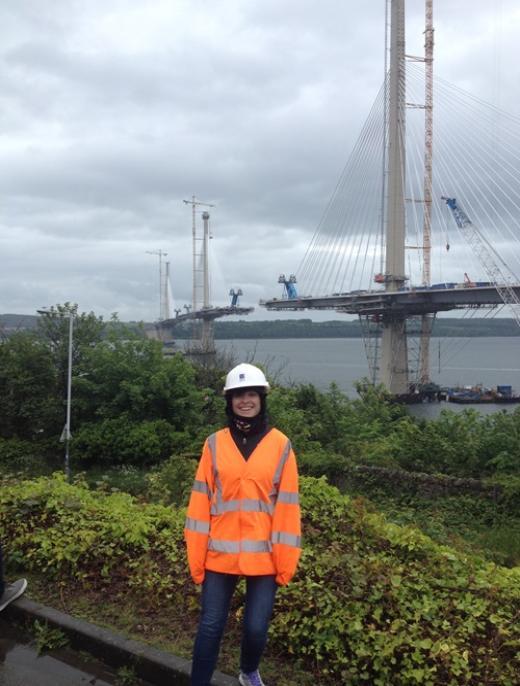Airflow and Architecture: How Fluid Dynamics Shapes Our Skylines
Friday, 27 September, 2024
The tragic incident of the Baltimore Bridge collapse serves as a stark reminder of the critical importance of integrating fluid dynamics into engineering practices. While the collapse of the bridge was due to the ship colliding with a bridge pier, understanding the prevailing current flows and how they might bring a ship off-course is hugely important, says (opens in a new window)Dr Jennifer Keenahan (UCD School of Civil Engineering).
 |
| A photograph of Jennifer standing in front of the Queensferry Crossing in Scotland during its construction. |
In the complex interplay between the natural elements and human innovation, the science of fluid dynamics plays a pivotal role, particularly in the design of the built environment. This discipline, which deals with the behavior of fluids (liquids and gases) in motion, is a cornerstone in engineering, especially when considering exposed structures, such as bridges.
Fluid dynamics, at its core, enables engineers to predict and analyze the effects of wind, water, and other fluid interactions on structures. When it comes to bridges, which often span vast water bodies or valleys and are subject to constant wind forces, understanding the nuances of fluid dynamics becomes not just beneficial but essential. Wind, a powerful and unpredictable force, can induce vibrations, sway, and even structural failures in bridges, making it imperative for engineers to design with wind behavior in mind.
A British Pathé video showing the oscillations and eventual collapse of the Tacoma Narrows Bridge in Seattle in 1940.
The famous collapse of the Tacoma Narrows bridge in 1940 underscores the catastrophic consequences of neglecting fluid dynamics in bridge design. The oversights and underestimations of wind loads in the design of that bridge served as a crucial turning point in the design of bridges for wind. While modern day design practices are far superior to those of the last century, the increasing wind speeds resulting from climate change pose a new and growing risk to our bridge stock. There is relatively little understanding of how bridges, or the vehicles on them, interact with stronger and more frequent storms.

A diagram illustrating the various types of motion that occur with wind-bridge-vehicle dynamic interaction
To being to mitigate such risks, engineers employ various fluid dynamics principles and tools, such as wind tunnel testing and computational fluid dynamics (CFD) simulations. Wind tunnel testing allows for the physical modeling of wind flow around a scaled version of the structure. On the other hand, CFD uses computer simulations of the fluid equations at full scale to assess the behavior of the structure exposed to a flow. More recently, the use of sensors on bridges is becoming more common, often termed ‘bridge health monitoring’. Each, in their own way, provides valuable data on potential wind-induced effects, such as vortex shedding and flutter in both the construction and operational stages, thus identifying potential issues before they manifest in the real world.
Moreover, the field of fluid dynamics also informs the development of design strategies aimed at mitigating adverse effects. For example, when the Millennium Bridge in London opened in 2000, it experienced unexpected lateral oscillations due to pedestrians, leading to crucial modifications informed by fluid dynamic principles. Fluid dynamics studies can also be used to design aerodynamically shaped bridge decks, which reduce wind resistance and deflection, as well as specify the use of tuned mass dampers, which absorb and dissipate energy. These innovations highlight how the field contributes not only to the safety and stability of bridges but also to their aesthetic and functional aspects.
 |
| A photograph of Jennifer at the mid-span of the Golden Gate bridge in San Fransisco – demonstrating how thick the cables are. |
Of course fluid dynamics is applied to the design of many other aspects of the built environment, such as ventilation studies, fire, smoke and visibility assessments, the dispersion of pollutants and effluent, and heat transfer in buildings. Collaboration between fluid dynamics experts and urban planners is essential in creating cities that harmonize with natural wind patterns and water flows, reducing the urban heat island effect.
As cities continue to grow vertically and become denser, the role of fluid dynamics in mitigating wind tunnels between skyscrapers and ensuring pedestrian comfort at street level becomes increasingly critical. Research into adaptive structures that can change shape in response to environmental conditions is also promising, potentially leading to buildings that can dynamically adjust to optimize energy use and occupant comfort.
The principles of fluid dynamics offer a foundation upon which safer, more reliable, climate resilient and innovative structures can be built. Embracing and advancing our understanding of fluid dynamics is essential for fostering a built environment that is in tune with the forces of nature, ensuring the safety and well-being of all who rely on these structures in their daily lives.
About the author
(opens in a new window)Dr Jennifer Keenahan (UCD School of Civil Engineering) is an Associate Professor in the School of Civil Engineering at UCD. Her PhD assessed methods of detecting damage in bridges using sensors installed on a passing vehicle. Following this, she practiced as a bridge and wind engineer at Arup and worked on a variety of national and international projects.